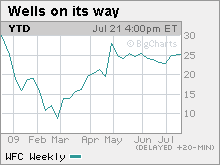Wells Fargo stages another strong quarter
The San Francisco-based bank earns $3.2 billion, better than Wall Street's estimates, but investors may worry about rising credit losses.
 |
| Despite Wednesday's selloff, Wells Fargo shares have nearly recouped all of the losses they suffered when the stock plunged in March. |
NEW YORK (CNNMoney.com) -- The Wells Fargo stagecoach rolled on with another impressive quarterly performance, even as credit losses continued to take its toll on the bank's balance sheet.
The San Francisco-based lender said Wednesday that it earned $3.17 billion, or 57 cents a share in the quarter, up 81% from $1.75 billion, or 53 cents during the same period a year ago. Profits came in well ahead of the earnings of $1.6 billion, or 34 cents a share that analysts were expecting according to Thomson Reuters.
Wednesday's results represent the second straight quarter of robust profits from Wells, after suffering a $2.6 billion loss late last year as a result of its decision to purchase the struggling East Coast banking giant Wachovia just months earlier.
"Our team achieved these results while undertaking the largest merger integration in U.S. banking history and despite the challenging economy," Wells Fargo CEO John Stumpf said in a statement.
Still, investors reacted skittishly to the bank's results Wednesday as Wells Fargo (WFC, Fortune 500) shares, which have more than tripled in value since its March lows, fell more than 6% in midday trading.
Expectations for the company were high heading into the quarter, as the company has tended to beat Wall Street's consensus estimates even during the downturn.
But credit trends during the quarter troubled some investors. Both the number of loans gone bad and those at risk of turning sour climbed from the previous quarter. Non-accruing loans, or those at risk of being written off, rose 50% to $15.8 billion, from $10.5 billion from the end of March.
Howard Atkins, Wells Fargo's chief financial officer, said in a recorded message to investors that part of that increase was due to marking down loans related to the Wachovia acquisition.
At the same time, Atkins noted that consumer-related loans performed about as expected during the quarter, and even showed some signs of improvement. He said there was a stabilization in early-stage delinquencies within its credit card business, for example.
With that in mind, one banking analyst said the company's performance should be lauded, not criticized.
"What has gotten lost is that they made $3 billion this quarter in one of worst economic periods in our lifetime," noted David George, senior bank analyst at Robert W. Baird & Co.
Unlike last quarter, where the company's results were lifted by mortgage refinancing activity, Wells Fargo cited broad-based strength across a number of its businesses, in addition to wide margins on new loans.
Even the Wachovia purchase, which has been plagued by ongoing loan difficulties, helped lift results, providing 39% of the combined company's $22.5 billion in quarterly revenue.
Executives at the company maintained that the integration of the two companies was "on track", and that the first of the planned conversions of Wachovia's retail bank branches into Wells Fargo branches is set for later this year.
"Our top priority is to integrate Wachovia into Wells Fargo as smoothly and efficiently as possible," said Stumpf.
The company also offered some insight into its role in the government's Troubled Asset Relief Program, or TARP, which several of its peers have already managed to escape.
Stumpf maintained Wednesday that the bank intended to return the $25 billion government investment it received last fall as part of TARP, but gave no timetable for doing so. He only indicated it would be done in a "shareholder-friendly way" and with the blessing of regulators.
Wells Fargo has also been busy raising capital after being asked by regulators to do so earlier this year as a result of the government's stress test program of the nation's 19 largest financial firms.
At the time the stress test results were announced in May, the company was ordered to raise $13.7 billion to insulate itself from the ongoing recession. The company has already bridged that gap, raising some $14.2 billion through a combination of money it has earned and an $8.6 billion equity offering it announced just before the results of the tests were made public.
Wells Fargo's results punctuate what has been a surprisingly impressive quarter for the nation's banks. Last week, Goldman Sachs (GS, Fortune 500), JPMorgan Chase (JPM, Fortune 500) as well as more troubled lenders Bank of America (BAC, Fortune 500) and Citigroup (C, Fortune 500), all reported much-better-than expected results.
Investment bank Morgan Stanley (MS, Fortune 500) reported a bigger loss than analysts were expecting Wednesday morning, however. ![]()

